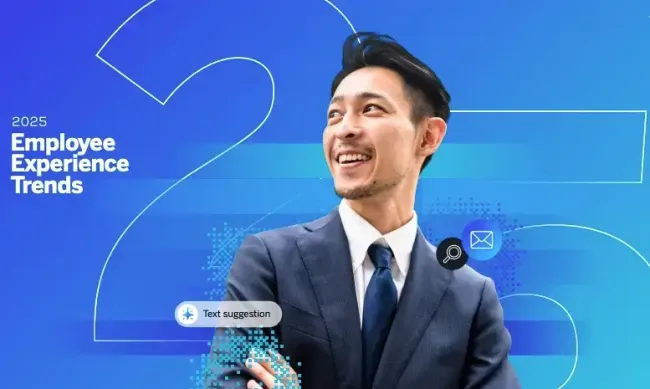Your employees’ experience and job satisfaction is shaped by your company’s culture, work environment, technology company strategy, products and services, and even the external macroeconomic environment. To improve it, you need an employee engagement strategy, and the backbone of that strategy must be listening.
Employee engagement strategies
- In-the-moment listening
- In-the-moment action
- Multi-radar feedback / 360° (or 180°) feedback
- Unstructured data
- Manager-led surveys
- Action planning with ideas board
- Data connection
We’ve known about the impact of engaged employees on business performance for a long time. Quite simply, when you engage employees, they are more focused on their role, their colleagues and your customers.
We’ve all met engaged employees – either as colleagues or customers – and been delighted by the experience.
Equally, we’ve all encountered disengaged employees, and been frustrated and dissatisfied with the experience.
In the current economic downturn, it’s those organizations that maximize employee engagement and the wider employee experience, and root out the causes of employee disengagement, that will survive and be in a position to thrive when the economy turns around.
Budgets and resources are constrained. People at all levels, from senior leaders through to frontline managers and even employees themselves are disproportionately investing time and energy into enhancing employee experiences to drive employee engagement and business performance.
In short, what’s needed is an effective employee engagement strategy.
Transform your employee engagement with Qualtrics Employee Experience
The traditional approach to employee engagement
Traditionally, for many organizations, the strategy to increase employee engagement revolved solely around the annual employee engagement survey. Typically, this was a heavy effort, needing weeks or even months of survey design, pre-survey communications, reporting, and, if there was any interest and energy left at the end, some action.
The annual employee engagement survey was frustrating – too infrequent, too slow, and often failing to drive engagement levels.
One study found that only 44% of employees have seen positive changes as a result of previous employee surveys, and just 42% have been given the opportunity to discuss last year’s survey results.
In short, the annual engagement survey approach became stagnant.
Now, with the development of technology and AI, and Experience Management recognized as a discipline, strategies for improving employee engagement have evolved beyond the annual survey – and even beyond engagement itself.
Employee engagement vs. employee experience
Before we explore current employee listening approaches, let’s understand the difference between employee engagement and employee experience:
Employee experience
This is the sum of all experiences a person has throughout their relationship with an organization – before, during and after. Employee engagement is one of the critical outcomes that’s a product of employee experience, and one of the metrics an organization should track to monitor its health.
Employee engagement
Employee engagement has been the mainstay of employee listening programs for decades. It has become a standard of employee listening because it has consistently been proven to be a predictor of employee and business success.
Employee engagement is more precisely defined as the combination of three factors:
1. Recommend: Advocacy, or likelihood to recommend the organization as a place to work.
2. Motivate: The willingness to give discretionary effort, or go above and beyond.
3. Personal accomplishment: Feeling that your work gives you a sense of accomplishment is key to having a sense of workplace purpose.
Listening across the entire employee lifecycle
Modern experience management programs that use AI and machine learning now let organizations capture feedback from employees at any time, and from anywhere, across the employee lifecycle:

Top 7 employee engagement strategies
Using the latest technology and AI across the above lifecycle stages, you’ll be able to quickly understand and identify insights from employees – whether they have job satisfaction or not.
Techniques used to support the measurement, analysis and action of employee feedback include:
1. In-the-moment listening
Rather than waiting for infrequent, scheduled surveys, employees can provide real-time feedback as they are having the experience. For example, when an employee uses an online tool, its use triggers a short, simple survey.
2. In-the-moment action
When feedback can be provided in real time, experience gaps can be identified quicker and actions can be taken to close those gaps almost instantaneously. For example, when a potential candidate reviews the job spec on an online careers page for a critical, hard-to-fill role, a site intercept survey could be triggered after one minute to ask what more information the person requires. This may help organizations increase their candidate pool and reduce time to hire.
3. Multi-rater feedback / 360° (or 180°) feedback
Multiple points of view – from peers, managers, direct reports – can be transformational in helping employees gain both broad and deep insights into their behavior and improve their performance and development opportunities.
4. Unstructured data
Undoubtedly surveys can provide robust data from across the organization, but there is a risk of survey fatigue. A wealth of untapped information already sits in Yammer, Slack channels, social media sites and the conversations with internal service centers – the necessary data and insight may already exist.
AI-driven analysis of unstructured data can quickly identify at scale the issues employees are raising, their feelings, and the impact these are having on their engagement and wider experience. Text and conversational analytics are the next frontier in employee listening and where organizations are increasingly turning to bolster their employee listening programs.
5. Manager-led surveys
With greater EX maturity comes the ability of local leaders and managers to engage more effectively with their employees using employee feedback. Organizations are using survey tools to empower local managers and leaders to capture frontline experience when they need to, on topics relevant to their team, but within the guardrails of curated surveys. Used on a common platform, HR and executive teams can also continuously monitor organization-wide sentiment.
6. Action planning with ideas boards
Local ownership extends beyond just the survey and insights, to include action planning. Ideas boards – where teams add ideas anonymously and up-vote each other’s ideas – can be used to crowdsource ideas about what exactly leaders could do to improve employee engagement. After collection, a manager will have a set of potential solutions for their focus areas on which they can act.
7. Data connection
While collecting feedback from different points of the employee lifecycle can be incredibly powerful, insights can be amplified when these data are combined into a single dataset.
For example, connecting onboarding feedback with engagement and pulse survey data can provide rich insights into the onboarding practices, company culture and processes that contribute to ongoing high levels of engagement (or disengagement and turnover).
When you connect exit survey data with engagement and pulse data you gain a richer picture of leavers – especially regretted leavers who exit for a competitor or similar role. Your engagement survey then becomes an early warning system of employees who share a similar profile to actual regretted leavers.
And when you go a step further by connecting EX feedback with customer or consumer feedback (CX), you’ll understand not only how employee engagement is correlated with the customer experience, but how the drivers of EX impact on CX. For example, you’ll understand which areas of the employee experience most influence customers’ purchasing decisions, and are most worth investing in. These insights enable organizations to invest in the areas of their employee experience because they impact business performance.



